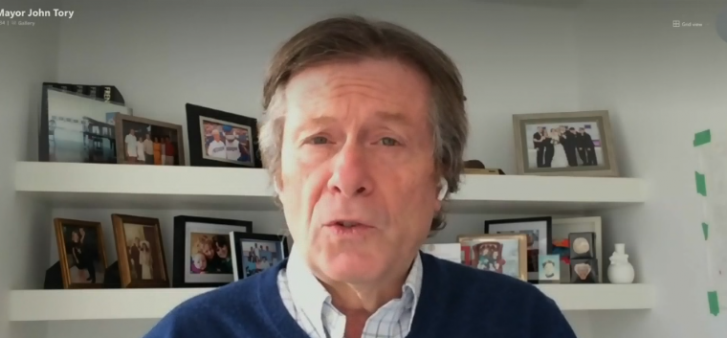This post is also available in: 简体中文 繁體中文
Vaccinating people in higher-risk neighbourhoods and workplaces, regardless of age, is a targeted approach the city should consider going forward, Mayor John Tory says.
Speaking to CP24 on Monday morning, Tory said taking vaccination teams to people who are more at risk of contracting COVID-19, including those who live in neighbourhoods where the virus is more prevalent, is something Toronto will likely “be doing more of.”

“I think what you are seeing now and what I’ve been talking about here is the notion that we would change some of our orientation, not to take it away from older people and that sort of thing and to completely abandon that priority list… but rather to look now at more targeted approaches to get people in priority neighbourhoods, almost regardless of their age,” Tory said.
“If they are working in a risky setting like a certain kind of factory or workplace or if they are just in neighbourhoods…where the spread has been more prevalent, those are the people now I think you’ll find on a more targeted basis we will try harder to reach out to and maybe take more of the vaccines into the community as much as that is a logistical challenge.”
The city opened its sixth mass immunization site at The Hangar in Downsview Park on Monday morning and all Toronto residents ages 60 and older are now permitted to book appointments at clinics across the city. In some priority neighbourhoods in the city, shots are available to people ages 50 and older.
To date, about 600,000 doses of COVID-19 vaccines have been administered in Toronto.
Tory said that while the city-run clinics and provincial booking system have worked “flawlessly,” there are still many appointments available.
“I’ll be perfectly honest about this, I thought when we opened up the large vaccine clinics that we have, people would be beating the door down. We’d have people that would be kind of line up even when they hadn’t registered to say, ‘I’m here. I want my vaccine now.’ That hasn’t been the case. There is a hesitancy for a number of reasons,” Tory said.
“So is there a need now to have a second look at this and to redouble our efforts and go into factories and workplaces which was… not as much on the higher end of the list but we’ve now seen it is a place where these variants are having outbreaks.”
The mayor said while there are some mobile clinics that are out vaccinating people in the community, he would like to see more of those teams become a part of Toronto’s vaccine rollout.
“Today, in fact there are 17 clinics running across the city, including what I’ll call mobile clinics that go into higher-risk neighbourhoods and places like that,” Tory said. “We need to probably increase the presence of those kinds of teams.”
Dr. Isaac Bogoch, a member of the province’s COVID-19 vaccine task force, said while essential workers and people in high-risk areas are being vaccinated as part of Phase 2 of the province’s vaccine rollout, more workers need to receive their first dose.
“This is happening… there are essential workers that are being vaccinated now. Does it need to expand? Of course. Is it happening enough? No, of course not. It needs to expand massively,” he said.
He said the province needs to focus on multiple priority groups simultaneously.
“We know even in this third wave the vast majority of people who die are over the age of 60. Age is still an extremely important issue that we need to focus on. We cannot lose sight of that. But there is a lot more to this than who lives and dies and of course you have to focus on where the fire is hottest,” Bogoch said.
“We know the fire is hottest in high-burden neighbourhoods that are often low-income neighbourhoods, racialized neighbourhoods, and among essential workers. And if you look at the Phase 2 rollout plan, it clearly identifies people who cannot work from home and essential workers.”
He noted that bringing shots directly to essential workers would help remove barriers to vaccination.
“I really liked Mayor Tory’s point about bringing the vaccine to the people rather than bringing the people to the vaccine. And of course public health units have mobile centres (and) pop-up centres,” he said.
“There is not going to be a one-size-fits-all strategy, but in places like Toronto and Peel, I think it would be a wonderful idea to bring the vaccine to the people… go directly to the source and vaccinate people on site. I think that whatever we can do to lower the barriers to vaccination, we should be doing and we should be taking extraordinary steps to do that.”
Article From: CP24
Author: Codi Wilson

